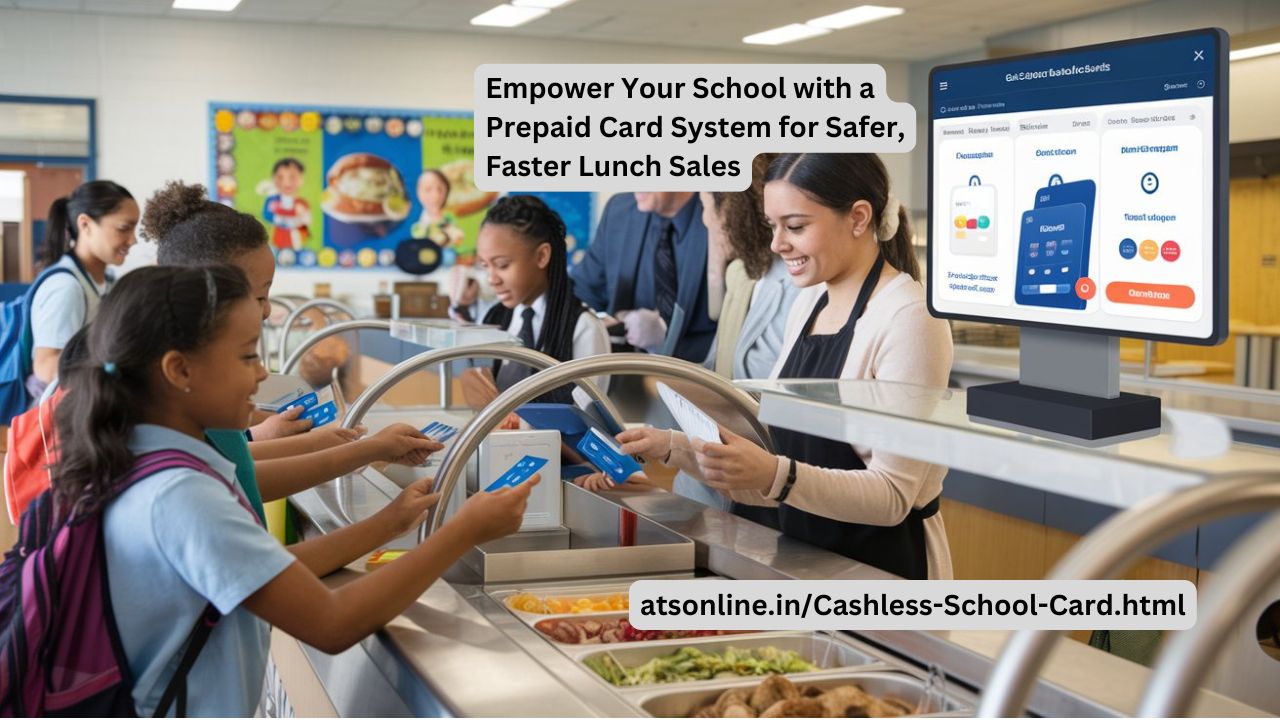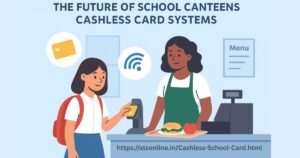Empower your school with a prepaid card system for safer, faster lunch sales, enhancing security, efficiency, and parental oversight.
In today’s rapidly evolving world, schools are constantly looking for ways to enhance security, improve efficiency, and provide a seamless experience for students, staff, and parents alike. One area that has seen significant technological advancements is the school cafeteria. With many schools still relying on cash or manual ticket systems, transitioning to a prepaid card system for lunch sales can bring about multiple benefits, from increasing safety to improving transaction speed and reducing administrative burdens. This article will explore how a prepaid card system can empower your school, creating a safer and faster environment for students and staff alike.
1. Introduction to Prepaid Card Systems in Schools
A prepaid card system involves issuing students with cards that are preloaded with funds, which they can then use to pay for meals and snacks at the school cafeteria. These systems eliminate the need for students to carry cash, improving both convenience and security. Many prepaid card systems also allow for online management, where parents can monitor their child’s spending and top up funds as needed.
This technology has gained popularity in recent years as schools increasingly prioritize student safety, operational efficiency, and a streamlined experience for both students and staff.
2. The Importance of School Safety and Efficiency
Student safety is a top priority in any educational environment. Handling cash in schools not only increases the risk of theft or loss but also can expose students and staff to potential security risks. Additionally, traditional cash systems are slow and can lead to long lines during lunch breaks, reducing the time students have to enjoy their meals and recharge for the rest of the school day.
A prepaid card system addresses both safety and efficiency concerns, offering a secure and fast way for students to pay for their meals without the need for physical cash or handling money on school premises.
3. Benefits of a Prepaid Card System for Lunch Sales
3.1 Improved Transaction Speed
One of the most immediate benefits of a prepaid card system is the improvement in transaction speed. Instead of students fumbling for cash or lunch tickets, they can simply swipe their card or tap it against a reader to complete their purchase. This dramatically reduces wait times in the lunch line, ensuring that more students can be served in less time.
Faster transactions also give students more time to enjoy their meals and socialize, contributing to a more relaxed and enjoyable lunch period.
3.2 Enhanced Security
Prepaid card systems eliminate the need for students to carry cash, reducing the risk of theft or loss. Additionally, the funds on the card can be tracked and monitored by both the school and parents, offering another layer of security.
In the event that a card is lost or stolen, it can easily be deactivated and replaced, unlike cash, which is gone for good once it’s lost. This added security brings peace of mind to both parents and school administrators.
3.3 Parental Oversight
With a prepaid card system, parents have better oversight of their child’s spending. Many systems allow for online portals where parents can see what their child is purchasing, set spending limits, and add funds as needed. This not only helps ensure that children are making healthy food choices but also provides parents with greater control over their child’s daily spending.
Some systems even allow parents to restrict certain items, ensuring their child can only purchase healthy, nutritious options.
3.4 Reducing Administrative Burdens
For schools, managing cash transactions can be time-consuming and labor-intensive. Cash needs to be counted, balanced, and secured at the end of each day. Mistakes can occur, leading to discrepancies in the till, and the handling of cash comes with inherent security risks for staff.
A prepaid card system automates much of this process, reducing the need for manual cash handling. School administrators can focus on other important tasks, while cafeteria staff can serve students more efficiently without worrying about counting change or managing large sums of money.
4. Implementation of Prepaid Card Systems
The implementation of a prepaid card system requires careful planning and execution. Here’s a step-by-step guide on how schools can transition to this new system:
4.1 Partner with a Reliable Vendor
The first step in implementing a prepaid card system is partnering with a reliable vendor. Look for a company that has experience working with schools and can provide a system that meets your institution’s specific needs. Some key features to look for include ease of use, online account management, and robust security measures.
4.2 Set Up the Card Distribution Process
Once a vendor is selected, the school will need to distribute the prepaid cards to students. This can be done at the beginning of the school year or upon enrollment for new students. It’s important to have a streamlined process in place for issuing and activating the cards to ensure a smooth transition.
4.3 Training for Staff and Students
Training is essential for the successful adoption of a prepaid card system. Both cafeteria staff and students need to be familiar with how the system works. Cafeteria staff should receive training on operating the card readers and handling any issues that may arise, such as lost or malfunctioning cards.
Students, especially younger ones, may need guidance on how to use their cards properly. Schools can run informational sessions or provide instructional materials to ensure students are comfortable with the system.
4.4 Online Account Management for Parents
Providing parents with easy access to an online portal where they can manage their child’s prepaid card is a crucial aspect of the system. Schools should ensure that parents are aware of this feature and know how to use it effectively. This portal should be user-friendly, allowing parents to add funds, monitor purchases, and set spending limits with ease.
5. Overcoming Challenges in Adoption
While a prepaid card system offers numerous benefits, there may be challenges during the transition period. Schools should be prepared to address these issues to ensure a successful implementation.
5.1 Initial Resistance from Students and Parents
As with any new system, there may be initial resistance from students and parents who are used to paying with cash. To overcome this, schools can provide detailed information on the benefits of the system and offer incentives for early adoption, such as discounts on meals for students who use their prepaid cards.
5.2 Technical Glitches
As with any technology, there may be technical issues, such as card readers malfunctioning or online systems going down. Schools should have a plan in place to address these problems quickly and ensure that lunch sales continue without major disruptions.
5.3 Balancing Digital and Traditional Payment Methods
Some families may not be able or willing to use a prepaid card system. In these cases, schools should consider offering both digital and traditional payment methods during the transition period to accommodate all students. Over time, as more families adopt the prepaid system, schools can gradually phase out cash payments.
6. Long-Term Benefits of Prepaid Card Systems
The long-term benefits of implementing a prepaid card system go beyond just faster lunch lines and improved security. Over time, schools can see a reduction in operational costs related to cash handling and an increase in overall efficiency.
Moreover, data collected from prepaid card transactions can provide schools with valuable insights into student preferences and meal patterns. This information can be used to make data-driven decisions about menu offerings, ensuring that schools are providing meals that students enjoy while meeting nutritional standards.
7. Case Studies: Schools Successfully Using Prepaid Card Systems
Several schools have already successfully implemented prepaid card systems with impressive results. For example, a school saw a 40% reduction in lunch line wait times after adopting a prepaid card system. Students reported that they appreciated the convenience of not having to carry cash, and parents felt more secure knowing their children’s money was safe.
Similarly, a high school implemented a prepaid card system and saw a significant drop in cash handling errors, allowing cafeteria staff to focus more on serving students rather than counting money.
8. Conclusion
In conclusion, empowering your school with a prepaid card system for lunch sales can lead to a safer, faster, and more efficient cafeteria experience. By reducing the need for cash transactions, improving security, and offering greater parental oversight, a prepaid card system can transform how your school manages lunch sales. While the transition may come with challenges, the long-term benefits far outweigh the initial hurdles. Schools that invest in prepaid card systems are not only improving the lunch experience for students but also setting a foundation for enhanced efficiency and security across the board.
By embracing this modern solution, schools can focus on what truly matters – providing students with a safe, secure, and enjoyable environment to learn, grow, and thrive.
We hope you enjoyed reading our blog posts about prepaid card school billing solutions. If you want to learn more about how we can help you manage your business, please visit our website here. We are always happy to hear from you and answer any questions you may have.
You can reach us by phone at +91 9810078010 or by email at ats.fnb@gmail.com. Thank you for your interest in our services.




